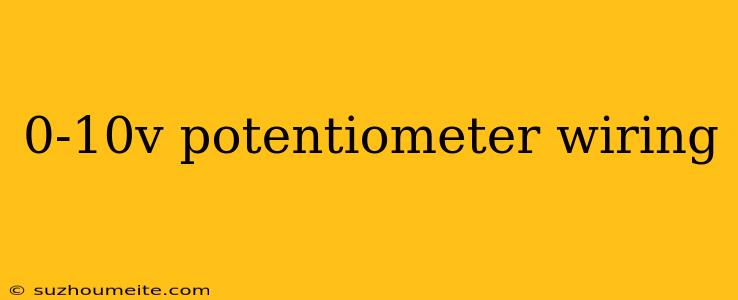0-10V Potentiometer Wiring: A Comprehensive Guide
In industrial control systems, potentiometers are widely used to measure linear displacement or angular rotation. One common type of potentiometer is the 0-10V potentiometer, which outputs a voltage signal that varies from 0 to 10 volts in response to changes in the input signal. In this article, we will discuss the wiring of a 0-10V potentiometer and its applications.
What is a 0-10V Potentiometer?
A 0-10V potentiometer is a type of potentiometer that outputs a voltage signal that varies from 0 to 10 volts. This type of potentiometer is commonly used in industrial control systems, such as those found in HVAC, lighting, and process control applications. The output voltage of the potentiometer is directly proportional to the input signal, which can be a mechanical position, pressure, or temperature.
Wiring a 0-10V Potentiometer
The wiring of a 0-10V potentiometer is relatively simple and involves connecting the potentiometer to a power supply and a load device, such as a controller or an actuator. The following diagram shows the basic wiring of a 0-10V potentiometer:
+-----------+
| |
| Power |
| Supply |
| |
+-----------+
|
|
v
+-----------+
| |
| 0-10V |
| Potentiometer |
| |
+-----------+
|
|
v
+-----------+
| |
| Load |
| Device |
| |
+-----------+
In this diagram, the power supply provides a stable voltage source to the potentiometer. The potentiometer outputs a voltage signal that varies from 0 to 10 volts, depending on the input signal. The load device receives the output voltage signal and responds accordingly.
Wiring Connections
The wiring connections for a 0-10V potentiometer are as follows:
- VCC: Connect to a stable power supply voltage (e.g., 12V or 24V).
- GND: Connect to the power supply ground or a common ground point.
- OUT: Connect to the load device, such as a controller or an actuator.
Applications of 0-10V Potentiometers
0-10V potentiometers have a wide range of applications in industrial control systems, including:
- HVAC Control: Used to control heating, ventilation, and air conditioning systems.
- Lighting Control: Used to control lighting systems, such as dimming and brightness control.
- Process Control: Used to control process variables, such as temperature, pressure, and flow rate.
Conclusion
In conclusion, 0-10V potentiometers are widely used in industrial control systems to measure linear displacement or angular rotation. The wiring of a 0-10V potentiometer is relatively simple and involves connecting the potentiometer to a power supply and a load device. With their high accuracy and reliability, 0-10V potentiometers are an essential component in many industrial control applications.
